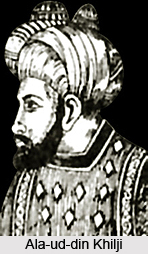 Economic condition of India was affluent under the reign of the Delhi Sultanate. In fact the enormous wealth tempted Mahmud of Ghazni to invade India several times and each time he got immense treasure from here. Malik Kafur, during the reign of Ala -ud -din Khilji, brought so much wealth in plunder from south India that the value of currency fell down in the north. The Sultans, the rulers of the independent provincial kingdoms and the nobles possessed vast wealth and lived a life of luxury and pleasure. There are many beautiful mosques, palaces, forts and monuments which were built during this period and this could not have been possible without the economic prosperity of the country.
Economic condition of India was affluent under the reign of the Delhi Sultanate. In fact the enormous wealth tempted Mahmud of Ghazni to invade India several times and each time he got immense treasure from here. Malik Kafur, during the reign of Ala -ud -din Khilji, brought so much wealth in plunder from south India that the value of currency fell down in the north. The Sultans, the rulers of the independent provincial kingdoms and the nobles possessed vast wealth and lived a life of luxury and pleasure. There are many beautiful mosques, palaces, forts and monuments which were built during this period and this could not have been possible without the economic prosperity of the country.
Agriculture
Agriculture was a major occupation at that time. Land was the source of production. Produce was generally sufficient. The village was a self-sufficient unit. The husbandman took to the tilling and harvesting of crops, the women folk lend their hands to various functions like taking care of the animals; the carpenters made implements; the blacksmiths supplied the iron parts of the implements; the potters made the household utensils; the cobblers mended or made the shoes and the plough harness and the priest performed the marriage rites and other ceremonies. There were subsidiary functions of the money-lender, the washerman, the sweeper, the cow-herd and the barber. Land was the pivot around which the whole village life revolved. The chief crops were pulses, wheat, rice, sugarcane, jute and cotton and many more. Medicinal herbs, spices were also grown and exported to a certain extent. Some new crops like tobacco, tea and coffee were also introduced. Among the fruits there were grapes, dates, plantains, apples, oranges, and jack-fruits. Production was for local consumption. Some people lived on the income derived from industries for which raw materials could be imported. The towns served as centers of distribution of agricultural products and industrial goods. The state took a large share of the produce in kind.
Industries
There were village and cottage industries. The labour employed was the family members; the technique was conservative. There were industries of sugar, scents and spirits. Weaving and spinning of cotton were the cottage industries during that period. A small-arm making industry was also working in full swing that time. There were also goldsmiths and silversmiths. There were no factories or big enterprises. The Sultans took a hand in building up big enterprises known as the `Karkhanas.` Craftsmen were employed under the direct supervision of officials to manufacture fashionable articles.
Textile industry was the biggest industry at that time. The textiles included cotton cloth, woollen and silks. Allied industries of embroidery, gold thread work and dyeing were also there. Some quantities were exported by Bengal and Gujarat. The famous centers of cloth manufacture were Deogir and Maha Devanagari in the Deccan, Delhi in the North, Sonargaon and Dacca in Bengal.
Trade and Commerce
Inland and foreign trade flourished. As for the internal trade we had the various classes of merchants and shop-keepers. The Gujaratis of the North, the Chettis of the South and the Banjaras of Rajputana were the main traders. Bigger deals in commodities were made in `mandis.` The Banjaras carried on the business of conveying agricultural and other products from one part of the country to another. The native bankers used to give loans and receive deposits. The chief articles of import were silks, velvets, embroidered stuff, horses, guns, gun-powder, and some precious metals. The chief items of export were grain, cotton, precious stones, indigo, hides, opium, spices and sugar. The countries affected by India in commerce were Iraq, Persia, Egypt, East Africa, Malaya, Java, Sumatra, China, Central Asia and Afghanistan.
Tax system
The Sultan of the Delhi Sultanate collected five categories of taxes which fall under the economic system of the empire. The taxes are Ushr, Kharaj, Khams, Jizya and Zakat. Besides, there were also other taxes. The main items of expenditure were expenses on the maintenance of the army, salaries of the civil officers and the personal expenditure of the Sultan and his palace.



















